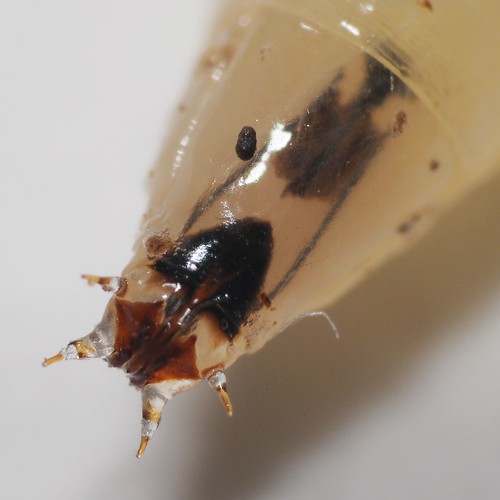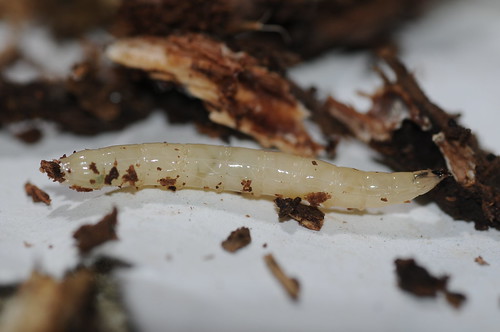Thread subject: Diptera.info :: Crane fly USA 2011-IV-22 (= Rhagio, not a crane fly)
Posted by John Carr on 25-04-2011 01:09
#1
Found in a small, rotten log next to a stream in Massachusetts, USA. I keyed it to
Epiphragma but it doesn't look like one -- creeping welts are small and there are four small, equal lobes around the spiracles. It's not a good match for the description of larva
E. fasciapenne (my local species) or the picture in the gallery of
E. ocellaris.
Length is 23 mm.
Head:

Tail:

Lateral:

Dorsal:

Click any picture for larger size.
Edited by John Carr on 25-04-2011 12:51
Posted by Cranefly on 25-04-2011 05:37
#2
I vote for Rhagio (Rhagionidae)???;)
Posted by atylotus on 25-04-2011 07:40
#3
You have my vote too
In Europe Rhagio has this typical headcapsule, so why not in USA.
Posted by John Carr on 25-04-2011 12:50
#4
Thanks. I thought the lobes were unique to Tipulidae (s. lat.). I once saw a
Rhagio mystaceus near this larva.
Edited by John Carr on 25-04-2011 12:52
Posted by atylotus on 25-04-2011 18:30
#5
Hello John
Rhagionidae larva can have four lobes (as in some species of former Limoniidae), but the posterior spiracles are positioned at the base of the dorsal lobes instead of in the centre part. The head capsule however is unique for Rhagio, and this type is not present in no species of former Limoniidae. The headcapule of Rhagio consists of two parts, an anterior part joint together by two thin lateral lines with the posterior part. This posterior part has a extra median extension protruded into a small lobe. In Limoniidae the headcapsule is almost completely chitinized to very much reduced, but never with a distinct anterior and posterior part.
Posted by Matt Bertone on 25-04-2011 19:25
#6
According to the MND, both
Chrysopilus (in part) and
Rhagio larvae have all of the characters shown...would need to look at the basal sclerite of the mandible to see if it is toothed (
Rhagio) or not (
Chrysopilus).
Posted by atylotus on 26-04-2011 09:13
#7
The difference in headcapsule between Rhagio (2 parts) and Chrysopilus (more complete capsule) is taken from Smith (1989:British flies) and Rüdiger Wagner (pers.comm.). Perhaps it is true for the palaearctic, but not for the Nearctic?
Posted by Matt Bertone on 27-04-2011 14:21
#8
You are most likely correct - all I have here is the MND key and it does not use the completeness of head capsule for ID. Maybe it is only true of certain Nearctic Chrysopilus....



